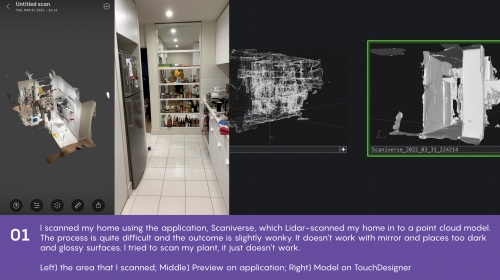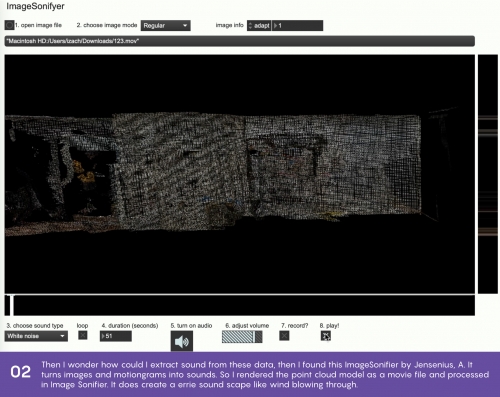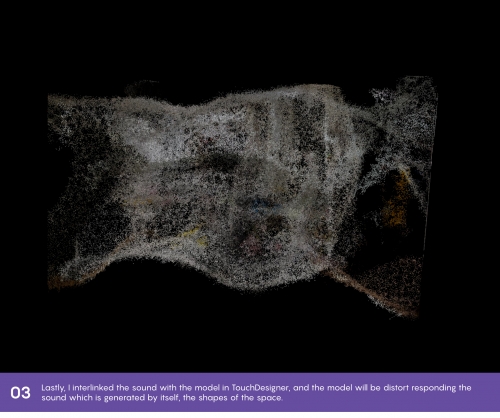
In response to the theme of object-oriented ontology (OOO), I carried out an experiment on how can space communicate in form of sound and visuals. OOO is definitely a thought-provoking ideology or contemporary artistic movement. However, I am emotionally reluctant to accept the idea that equality of beings could be brought about by excluding the involvement of humans or purposely diminishing the presence of humans. To me, this process itself contradicts what it advocated.
I questioned myself, where does this repulsion come from?
Q/ Is it me being anthropocentric without knowing? Have I been producing works that are anthropocentric?
Yes, as an UI/UX designer, what I have been taught and practiced is basically user-centric.
Q/ Do I believe objects have other ways of existence or communicating?
Yes and no, I do believe there are too many unrevealed secrets of beings in the world, and objects might work differently in other objects’ eyes. Though I love the imaginations of how humans will be overruled and how pencils strive to get lit up to be a torch, I don’t believe in these. It depends on how speculative the realism is.
Q/Why artists are creating under this idea?
Probably because they did this out of the concern of humans is exploiting the resources of the world. And people are creating objects mostly “form follows function”, the designated function is for human, it could be different from other being’s perspective.
Q/ What is the thing that I found most irritating to me?
It’s the contradiction between belief and practice.
-
Contradiction The idea of respecting the speculative/ possible lives/ world of objects, but the work is exploiting objects. Zoomdrams by Pierre Huyghe , the artist created impressive scenes like releasing crabs in the museum at night, using unexpected objects as the shell for hermit crabs. (Kerr, 2022) All of these are trying to detach humans from the world, and I totally found the idea and work interesting. But is it treating all objects as equal? I don’t think so. I feel it’s just an alternative view of the human gaze to the environment and humans, and somehow exploiting the objects picked.
-
Overpackaging creation as object-oriented. Eduardo Navarro performed Timeless Alex at the New Museum Triennial (2015), where he dressed up like a turtle and walk in the square.(Kerr, 2022) I found this idea fun and visually impactful, but then how is it challenging people’s imagination and arousing concerns and respect for beings?
-
Human gaze, interpretation, and projection from artist and audience are inevitable. To me, one object could never be object-oriented for another object, most of the time is a pure projection of imagination. The bird found and nested on an artificial device, is the bird living its life built on another object, it is also exploiting something else if we talk about object equality. Everything could only be self-oriented when it comes to being. But there is a huge spectrum sitting between being exploitative and anthropocentric. I am more interested in how to bridge the two.
Despite all these reflections, I still think this encounter with this OOO is very inspiring. It is rare to come across ideas that stimulate thoughts and reflections, especially after working in a commercial environment for a few years. This is rare and I appreciate and respect it even I am not that sold on the definition and practices of OOO. I love the idea it promotes and reminds humans of — equality and the importance of other beings. To me, I will feel more comfortable making something out of this thought but not in the name of OOO. So I am interested in how to make a space to neutrally (as possible) express itself and allow humans to understand/ be aware of it. Due to the limitation of time, I would just experiment and tinker with this idea.
I have an idea called, Passive Voice. A space that makes sounds by its shape, if things/ people come into the space, the sound will vary according to the occupancy of the space.
By scanning a part of my home into a point cloud model by using Scaniverse. I am able to turn the data into audio by using ImageSonifier(Jensenius, 2022), which basically just scans and analyses the RGB data and creates sound accordingly. Then I imported the audio into Touchdesigner and the point clouds to react with the sound made by its shape. I am imagining if I have an exhibitory area and technical capacity, I could set up a live Lidar scan of the area perhaps in timed intervals, and generate sounds out of the change of the point cloud (visitors come in/ they put down some objects), while the visualization will be put in the center of the room. The concept is that space is a passive object towards the active object, they have no say in what is coming in, but if we introduce agents of translation, by giving the voice to passive objects, hoping the audience could be more aware of these passive objects, especially the space. The reaction and sound will be very neutral, when there is change, the sole purpose is to remind the audience and reflect on themself what does the change mean, are there too many things inside, and why there is a response? This reflection I believe will remind visitors of the presence of other beings.
Similar work has been produced by Refik Anadol Studio, whose work “Wind of Boston” explores this theme through data visualization. (Anadol, 2022) They leveraged the wind speed, direction data at 20-second intervals throughout the year in Boston to create this work. This work allows the audience to appreciate the beauty of invisible beings, the wind. And to me it builds a bridge between humans and other beings, as these datasets are something humans could not comprehend in real life without the help of a computer, this provides another perspective for the audience to understand except physically feel it.
Kerr, D., 2022. What Is Object-Oriented Ontology? A Quick-and-Dirty Guide to the Philosophical Movement Sweeping the Art World.[online] Artspace. Available at: https://www.artspace.com/magazine/interviews_features/the_big_idea/a-guide-to-object-oriented-ontology-art-53690[Accessed 1 April 2022].
Anadol, R., 2022. Wind of Boston. [online] Available at: https://refikanadol.com/works/wind-of-boston-data-paintings/ [Accessed 1 April 2022].
Jensenius, A., 2022. ImageSonifyer.[online] Available at: https://www.uio.no/ritmo/english/research/labs/fourms/software/ImageSonifyer/index.html [Accessed 1 April 2022].
About This Work
By Izac, Kin Kui Ho
Email Izac, Kin Kui Ho
Published On: 01/04/2022



